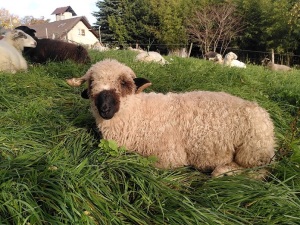Thônes et Marthod (F)
Description
The fleece of the breed is unicoloured white. Its head is fine with slight Roman profile. Mouth and nose are black; animals have black spots around their eyes. The horns are broad. Some ewes are unicoloured black exept for the white tip of the tail.
General and History
The relationship with breed from the Balkans is obvious. They are said to be also related to the Central European breeds. The breed received its name from Mr. Marthod (Albertville) and Mr. Thones (Haut Savoie) who owned all livestock in the area arond 1870. Formely, another branch of the breed, Noir de Fumex, was kept in the area around Fumex.
Distribution in the past and today
Thônes-Marthod descended vorm a bredd from the Mediterranean region; most probably from the fomer Kindom of Piémont-Sardaigne.
Utilization
Supply meat, wool and milk.
Keeping
Because of its robustness, animals can stay for 3-4 months at the highest Alpine regions with nearly on care. The breed ist very well adapted to high mountain regions from 2000-3000m with extreme temperature differences. The easly bear the 2-6 months housing under difficult conditions in open barns during wintertime.
Performance
Body weight: 80 - 90kg (m), 55 - 65kg (w)
Withers height: 80cm (m), 60 - 70 cm (w)
Fleece weight: 3kg (m), 2kg (w)
Lambing percentage: 150%
Processing and products
The milk is suited to produce best-quality cheese.
Schafrassen der Alpen, Antje Feldmann, Ursula Bietzker, Dr. Christian Mendel, Herausgeber: Gesellschaft zur Erhaltung alter und gefährdeter Haustierrassen e.V. - GEH, Deutschland, Sept. 2005
Günter Jaritz: Seltene Nutztiere der Alpen, 7000 Jahre geprägte Kulturlandschaft, Verlag Anton Pustet 2014
CORAM - collectif des races de massif








